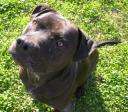History:
The Staffordshire Terrier traces its origins back to the English region of Staffordshire in the 1800s during which time there was various cross breeding among the Bulldog and various terriers. Once brought to the United States the large, muscular head and increased girth exhibited by these dogs was preferred by American breeders and as a result the Am Staff is much larger and heavier than its British cousin, the Staffordshire Bull Terrier. After the banning of dog fighting in the US around 1900 two strains of this type of dog resulted, a show strain called the American Staffordshire and less stocky breed known as the Pit Bull Terrier. Under the right ownership these are wonderful family dogs and they can be seen in various roles such as police work, weight pulling and agility.
Characteristics:
Do not be fooled by their muscular physique, the American Staffordshire Terrier is a devoted, gentle and loving family pet. These dogs require leadership from a strong pack leader that will show them what types of behaviors are acceptable/unacceptable. They can be courageous and tenacious fighters if provoked, and their tendency for dog aggression as well as a strong prey drive needs to be properly addressed by their owner. Their love for people, however, is unmistakable and their natural temperament toward people is gentle, sensitive and loving.
Temperament:
Am Staffs are happy, outgoing, intelligent, confident and stable dogs. They exhibit high levels of devotion toward their owners and absolutely adore children. They are a very good-natured and tolerant family pet; a perfect companion for a 2 year old that likes to pull on tails or bite ears. These dogs are almost always obedient wanting nothing more than to please their masters at all times. American Staffordshires are also known for their goofy sense of humor. Am Staffs are often dog aggressive in addition to having a very strong prey drive, and are not recommended for passive owners due to their need for structure and guidance. These dogs will fight an enemy to the death if they feel their pack is being threatened.
Care/Exercise:
Am Staffs do best with regular daily exercise, a long walk once per day is sufficient. Minimal grooming of the coat is recommended, use dry shampoo and bathe only when necessary; simply rubbing the coat will make it shine.
Health Issues:
While generally healthy, some are prone to hip dysplasia, hives, hereditary cataracts and congenital heart disease.
Average Height: 17 to 19 inches
Average Weight: 40 to 50 pounds
Colors: Red, fawn, white, black or blue with white, any shade of brindle.
Category: Terrier, Mastiff


We have just adopted two puppies from animal shelters- 1 is a lab mix and the other is a staffordshire terrier. I was very cautious at first because I didn’t know what attitude the staffordshire would have. Now, I have to say that the lab is actually more aggressive than the terrier. He is as laid back and calm as she is hyper. I have two small children and they adore him, and he adores them. I don’t think people should just group ALL of the breed together. However, there are a lot of these dogs that have been inbred and I have seen them snap in an instant. I worry about the breeders that are doing this just to make a few bucks. These are the ones people need to be afraid of. I don’t see why lawmakers can’t make breeders get a special license to breed and monitor them instead of trying to ban a certain breed because of a few rotten apples. They could always take dogs that are unlicensed.
I agree that the amstaffs are great dogs. (Being an owner of one myself)I disagree on the inbreeding thou. I do not believe that it is due to bad bloodlines that makes a dog “snap”, dogs always show a sign of irritation before they attack. A dog NEVER attacks for know reason.
We recently got a Staffordshire bull terrier. She came from a shelter around 8 months old. We had her for 6 months. She has came a long way with firm rules. I recently took her out of the crate at night. And she’s doing great. And seems calmer in the mornings. I want to leave her home out of the crate if I have to be gone for several hours. But I have trust issues with her. She has shredded any pad or blanket that we put in there. I know she has separation anxiety. But was wondering if she would do better leaving her in the livingroom. But I’m afraid I come home to a destroyed chair or couch. Any ideas or helpful ideas would be greatly appreciated